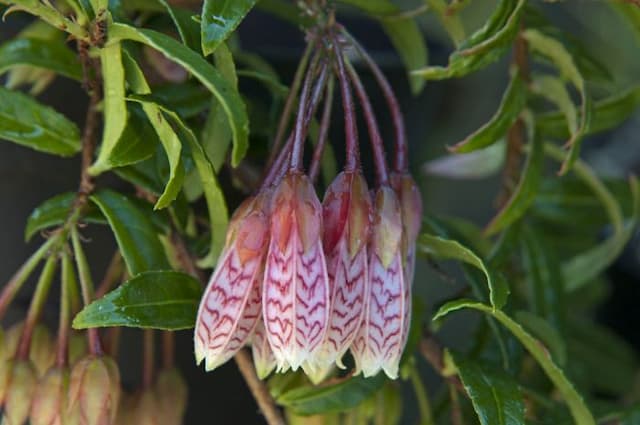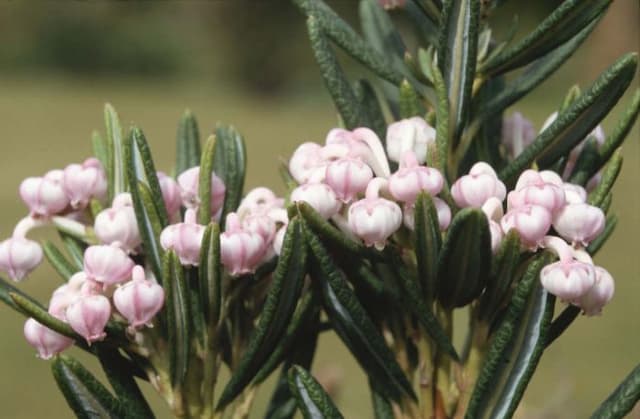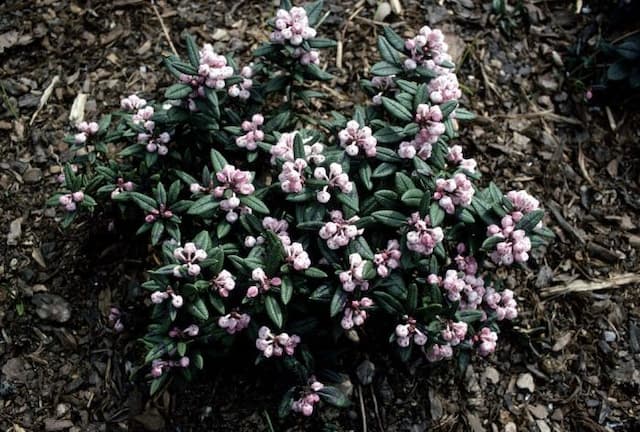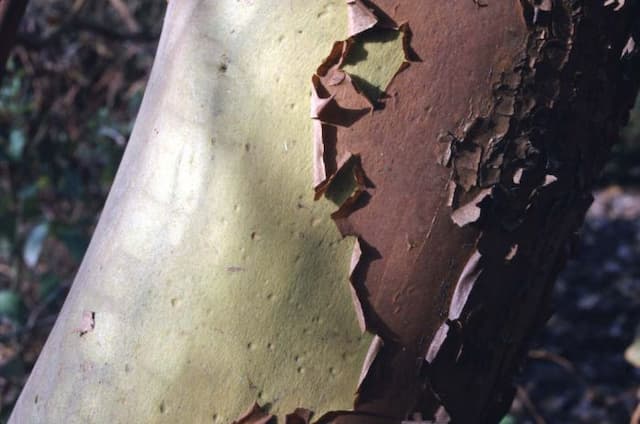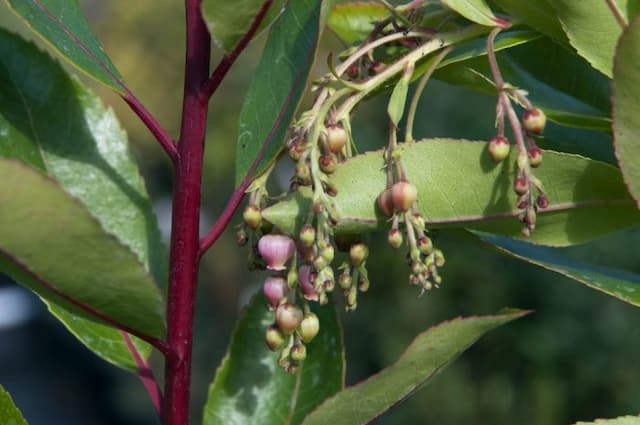Doker La Rhododendron Rhododendron primuliflorum 'Doker-la'
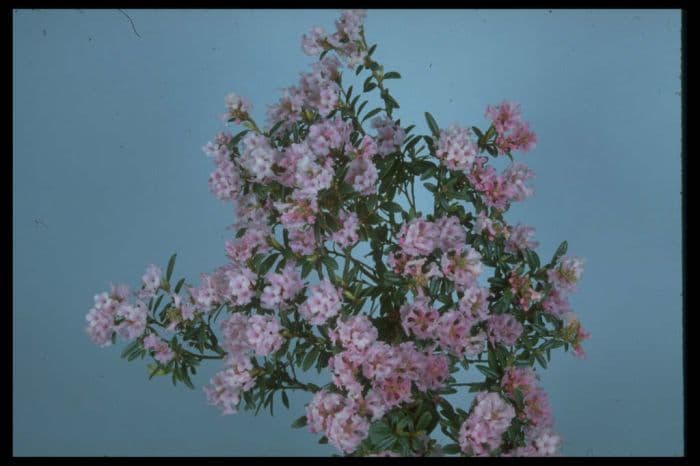
ABOUT
Rhododendron primuliflorum 'Doker-la', commonly known as Rhododendron, is a visually striking plant recognized for its attractive flowers and foliage. This particular variety is characterized by its vibrant, bell-shaped blossoms that come in a shade of pinkish-purple. The flowers typically cluster at the ends of the branches, creating a dense display of color when in full bloom. The leaves of the Rhododendron 'Doker-la' are equally notable, being leathery and dark green in color. The foliage often has a glossy sheen on the surface, adding to the plant's ornamental appeal. The leaves are elliptical in shape and come to a pointed tip, arranged in a spiral pattern along the stems, which gives the plant a lush, full appearance. Overall, the Rhododendron 'Doker-la' is cherished for its showy flowers and attractive evergreen foliage that provide year-round interest in a garden setting. Its aesthetic beauty makes it a popular choice among gardeners and plant enthusiasts for adding a splash of color to the landscape.
About this plant
 Names
NamesFamily
Ericaceae
Synonyms
Doker-La Primula Rhododendron, Doker-La Rhododendron
Common names
Rhododendron primuliflorum 'Doker-la'.
 Toxicity
ToxicityTo humans
Rhododendron, including the variety Rhododendron primuliflorum 'Doker-la', contains toxic compounds known as grayanotoxins. Ingesting any part of a Rhododendron can cause poisoning in humans. Symptoms of Rhododendron poisoning may include vomiting, diarrhea, hypersalivation, weakness, hypotension (low blood pressure), and bradycardia (slow heart rate). In severe cases, cardiac failure and coma can occur, which can be life-threatening. It is important to seek medical attention immediately if ingestion is suspected.
To pets
Rhododendron, including the variety Rhododendron primuliflorum 'Doker-la', is toxic to pets due to the presence of grayanotoxins. Pets, particularly dogs and cats, that ingest any part of a Rhododendron plant may exhibit symptoms such as vomiting, diarrhea, drooling, weakness, incoordination, and in severe cases, seizures, coma, or even death. Immediate veterinary care is crucial if a pet is suspected to have ingested Rhododendron.
 Characteristics
CharacteristicsLife cycle
Perennials
Foliage type
Evergreen
Color of leaves
Green
Flower color
Yellow
Height
5 feet (1.5 meters)
Spread
5 feet (1.5 meters)
Plant type
Shrub
Hardiness zones
7
Native area
Asia
Benefits
 General Benefits
General Benefits- Ornamental Appeal: Adds vibrant color and aesthetic value to gardens with its bright blooms.
- Habitat Support: Provides nectar for pollinators, such as bees and butterflies, which can aid local ecosystems.
- Shade Tolerance: Can grow in partially shaded areas, offering flexibility in garden design.
- Seasonal Interest: Often features springtime flowers that can enliven the landscape after winter.
- Versatility: Can be used in various landscape applications, such as borders, foundations, and woodland gardens.
 Medical Properties
Medical PropertiesThis plant is not used for medical purposes.
 Air-purifying Qualities
Air-purifying QualitiesThis plant is not specifically known for air purifying qualities.
 Other Uses
Other Uses- Rhododendron primuliflorum is sometimes used as a natural dye source, where different parts of the plant can provide colors for fabrics and textiles.
- In horticulture, the species can be used as a rootstock for grafting more delicate rhododendron species, thus providing them with hardier roots.
- Because of its attractive flowers, Rhododendron primuliflorum is often used in professional landscape designs, especially in rock gardens and alpine displays.
- Enthusiasts of the plant sometimes use the dried flowers of Rhododendron primuliflorum for crafting, including making flower arrangements and potpourri.
- The thick leaves are sometimes used in small-scale mulching, providing an acidic element benefiting other acid-loving plants.
- Some cultures use Rhododendron primuliflorum branches in traditional ceremonies for decorations due to their symbolic meanings and beauty.
- The flowering plant can serve as a natural indicator of the change in seasons, particularly in temperate regions where it blooms in a predictable pattern.
- Insect-loving gardeners value the plant as it attracts pollinators like bees and butterflies, promoting biodiversity in the garden.
- Artists and photographers often use scenes of Rhododendron primuliflorum in full bloom as beautiful subjects for their work.
- There is a niche practice of using Rhododendron flowers, specifically, in the culinary field for garnishing and decorating high-end dishes and desserts.
Interesting Facts
 Feng Shui
Feng ShuiRhododendrons are not specifically used in Feng Shui practice.
 Zodiac Sign Compitability
Zodiac Sign CompitabilityRhododendrons are not used in astrology practice.
 Plant Symbolism
Plant Symbolism- Warning and Caution: Rhododendron, which includes the species Rhododendron primuliflorum 'Doker-la', may symbolize caution or warning because some species contain toxins that can be harmful if ingested.
- Beware: In particular cultures or contexts, the plant can represent a warning to be cautious about what appears to be beautiful, as not all is safe or beneficial.
- Elegance and Wealth: Rhododendrons are often seen as a symbol of sophistication and abundance due to their lush, vibrant blooms which can signify the flourishing nature of prosperity.
 Water
WaterThe Rhododendron, commonly known as the Dwarf Rhododendron, prefers a consistent moisture level, so it's important to water it when the top inch of soil feels dry to the touch. Typically, this equates to watering the plant once or twice a week, but this can vary depending on climate and weather conditions. It's best to water deeply, using enough water to soak the roots; this might mean using about 1 gallon of water per plant each time you water. Avoid over-watering, as waterlogged soil can lead to root rot in Rhododendrons. During the winter, reduce watering since the plant's water requirements decrease.
 Light
LightDwarf Rhododendrons thrive in locations with dappled sunlight or partial shade. They should be protected from the intense afternoon sun, which can scorch their leaves. A spot that receives filtered morning light and shade during the hottest part of the day is ideal. These plants can also do well in areas with high, light canopies that provide sun protection.
 Temperature
TemperatureDwarf Rhododendrons prefer moderate temperatures and can suffer in extreme heat or cold. They can generally tolerate temperatures down to about 5°F and up to 80°F. The ideal temperature range for these plants is between 50°F and 75°F for optimal growth and flowering.
 Pruning
PruningPrune Dwarf Rhododendrons to maintain shape and encourage robust growth. The best time to prune is shortly after the flowering period ends in spring. Remove any dead or damaged branches, and trim back areas that are growing too large or interfering with the plant's structure. Pruning should be done annually as needed.
 Cleaning
CleaningAs needed
 Soil
SoilThe best soil mix for Rhododendron primuliflorum, commonly known as Early Rhododendron, is acidic, well-draining, and rich in organic matter. A combination of pine bark, peat moss, and perlite is ideal to ensure proper drainage and aeration. The soil pH should be between 4.5 and 6.0 for optimal growth and health.
 Repotting
RepottingEarly Rhododendrons should be repotted every 2 to 3 years to refresh the soil and to accommodate root growth. It is best to repot these plants in the spring before they enter their active growing season.
 Humidity & Misting
Humidity & MistingEarly Rhododendron prefers moderate to high humidity levels, generally ranging from 50% to 60%. Maintaining these humidity levels will help mimic the plant's natural environment and promote healthy growth.
 Suitable locations
Suitable locationsIndoor
Provide bright, indirect light and monitor humidity.
Outdoor
Part shade, protect from harsh sun and wind.
Hardiness zone
7-9 USDA
 Life cycle
Life cycleRhododendron primuliflorum 'Doker-la', commonly known as Rhododendron, begins its life cycle with seed germination, which requires a cold period to break dormancy before they sprout in moist, well-drained acidic soil. Upon germination, the seedling stage involves the growth of the first true leaves and establishment of the root system. As it enters the vegetative stage, the plant develops a woody stem and foliage, with leaves that are typically evergreen. The Rhododendron then reaches the flowering stage, producing blossoms that are often brightly colored and bell-shaped, attracting pollinators such as bees and butterflies. Following pollination, the plant forms seed capsules that mature and eventually release seeds, thus completing the reproductive cycle. Finally, the plant may enter a period of dormancy during colder months, conserving energy to recommence growth in the following season.
 Propogation
PropogationPropogation time
Spring-Early Summer
The most popular method of propagating Rhododendron primuliflorum 'Doker-la', commonly known as Primula Rhododendron, is by semi-hardwood cuttings. This process typically commences during the late summer months. To propagate by cuttings, one should select a healthy stem with several leaf nodes and cut a 4 to 6 inch (10 to 15 cm) length. The lower leaves are removed and the cut end is often dipped in a rooting hormone to encourage growth. The cutting is then inserted into a mixture of peat and perlite or a similar well-draining medium, and kept moist and under indirect light. A plastic cover can be used to maintain humidity. Roots usually develop within several weeks, after which the new plants can be gradually acclimatized to outdoor conditions before planting out.
